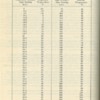quote:
Originally posted by jb1490:
Here's an old R12 chart from the 60's.
John
John,
Where did you get that chart? I collect old a/c and refrigeration stuff, amonst other things. Ever see hoarders? Nothing on my garage, snicker.
Careful tho, most of those charts were made for specific pieces of equipment or cars. For instance, the operating pressures on a C-10 '70 pickup are not identical for a same year continental, or a 73 Pantera. They may be close but they are all different system with different operating conditions, also the same 3 vehicles in 3 different states with different humidity conditions....different operating pressures. The chart can be close as a baseline for R-12. I would still use a combination of guages, temperature sensor at evaporator and sight glass when charging, from a starting vacuum with my refrigerant tank on a scale. Once done, I would note the full charge for future reference.
Angelo


